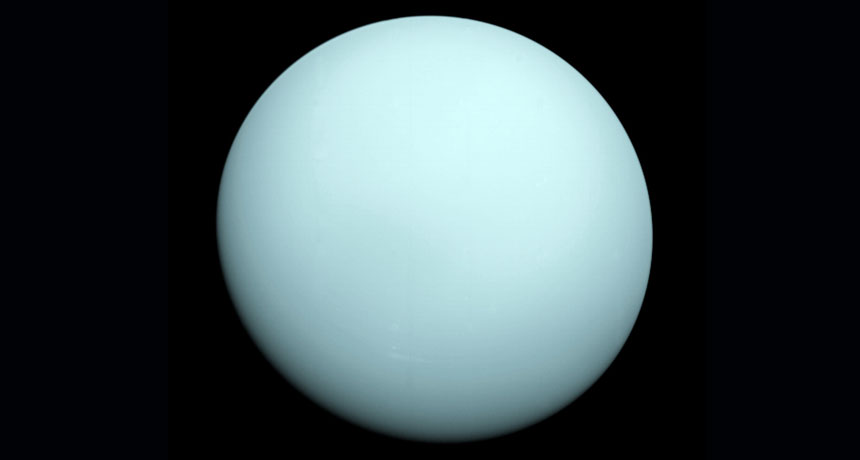ammonia A colorless gas with a nasty smell. Ammonia is a compound made from the elements nitrogen and hydrogen. It is used to make food and applied to farm fields as a fertilizer. Secreted by the kidneys, ammonia gives urine its characteristic odor. The chemical also occurs in the atmosphere and throughout the universe.
astronomy The area of science that deals with celestial objects, space and the physical universe. People who work in this field are called astronomers.
atmosphere The envelope of gases surrounding Earth or another planet.
cloud A plume of molecules or particles, such as water droplets, that move under the action of an outside force, such as wind, radiation or water currents. (in atmospheric science) A mass of airborne water droplets and ice crystals that travel as a plume, usually high in Earth’s atmosphere. Its movement is driven by winds.
colleague Someone who works with another; a co-worker or team member.
crystal (adj. crystalline) A solid consisting of a symmetrical, ordered, three-dimensional arrangement of atoms or molecules. It’s the organized structure taken by most minerals.
deter An event, action or material that keeps something from happening. For instance, a visible pothole in the road will deter a driver from steering his car over it.
gas giant A giant planet that is made mostly of the gases helium and hydrogen. Jupiter and Saturn are gas giants.
hydrogen The lightest element in the universe. As a gas, it is colorless, odorless and highly flammable. It’s an integral part of many fuels, fats and chemicals that make up living tissues. It’s made of a single proton (which serves as its nucleus) orbited by a single electron.
Jupiter (in astronomy) The solar system’s largest planet, it has the shortest day length (10 hours). A gas giant, its low density indicates that this planet is composed of light elements, such as hydrogen and helium. This planet also releases more heat than it receives from the sun as gravity compresses its mass (and slowly shrinks the planet).
molecule An electrically neutral group of atoms that represents the smallest possible amount of a chemical compound. Molecules can be made of single types of atoms or of different types. For example, the oxygen in the air is made of two oxygen atoms (O2), but water is made of two hydrogen atoms and one oxygen atom (H2O).
Neptune The furthest planet from the sun in our solar system. It is the fourth largest planet in the solar system.
planet A celestial object that orbits a star, is big enough for gravity to have squashed it into a roundish ball and has cleared other objects out of the way in its orbital neighborhood. To accomplish the third feat, the object must be big enough to have pulled neighboring objects into the planet itself or to have slung them around the planet and off into outer space.
reservoir A large store of something. Lakes are reservoirs that hold water. People who study infections refer to the environment in which germs can survive safely (such as the bodies of birds or pigs) as living reservoirs.
risk The chance or mathematical likelihood that some bad thing might happen. For instance, exposure to radiation poses a risk of cancer. Or the hazard — or peril — itself. (For instance: Among cancer risks that the people faced were radiation and drinking water tainted with arsenic.)
Saturn The sixth planet out from the sun in our solar system. One of the four gas giants, this planet takes 10.7 hours to rotate (completing a day) and 29 Earth years to complete one orbit of the sun. It has at least 53 known moons and 9 more candidates awaiting confirmation. But what most distinguishes this planet is the broad and flat plane of seven rings that orbit it.
solar system The eight major planets and their moons in orbit around our sun, together with smaller bodies in the form of dwarf planets, asteroids, meteoroids and comets.
spectrograph An instrument used to record light and separate it into its spectrum.
sun The star at the center of Earth’s solar system. It’s an average size star about 26,000 light-years from the center of the Milky Way galaxy. Also a term for any sunlike star.
telescope Usually a light-collecting instrument that makes distant objects appear nearer through the use of lenses or a combination of curved mirrors and lenses. Some, however, collect radio emissions (energy from a different portion of the electromagnetic spectrum) through a network of antennas.
Voyager spacecraft Two NASA missions to conduct close-up explorations of Jupiter, Saturn, Saturn's rings and the larger moons of the both large planetary gas giants. Despite their names, the Voyager 2 craft launched Aug. 20, 1977; Voyager 1 launched 16 days later. Both are near the edge of the solar system and still flying on into space.
wavelength The distance between one peak and the next in a series of waves, or the distance between one trough and the next. Visible light — which, like all electromagnetic radiation, travels in waves — includes wavelengths between about 380 nanometers (violet) and about 740 nanometers (red). Radiation with wavelengths shorter than visible light includes gamma rays, X-rays and ultraviolet light. Longer-wavelength radiation includes infrared light, microwaves and radio waves.








